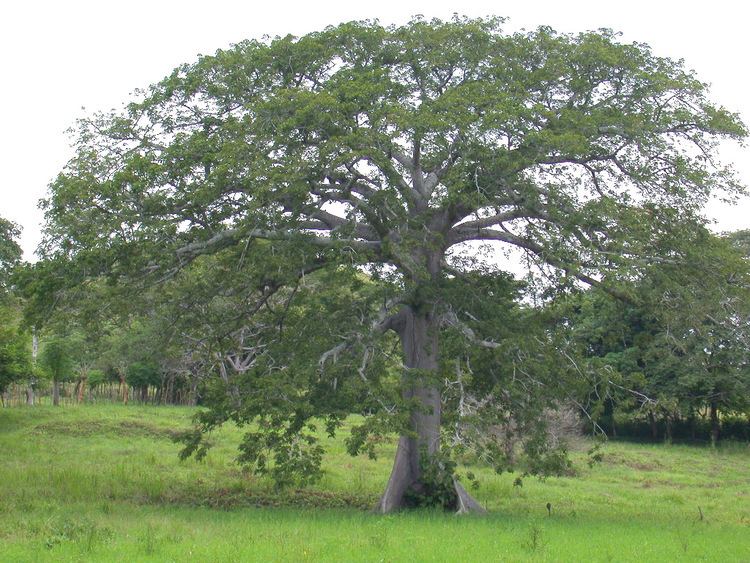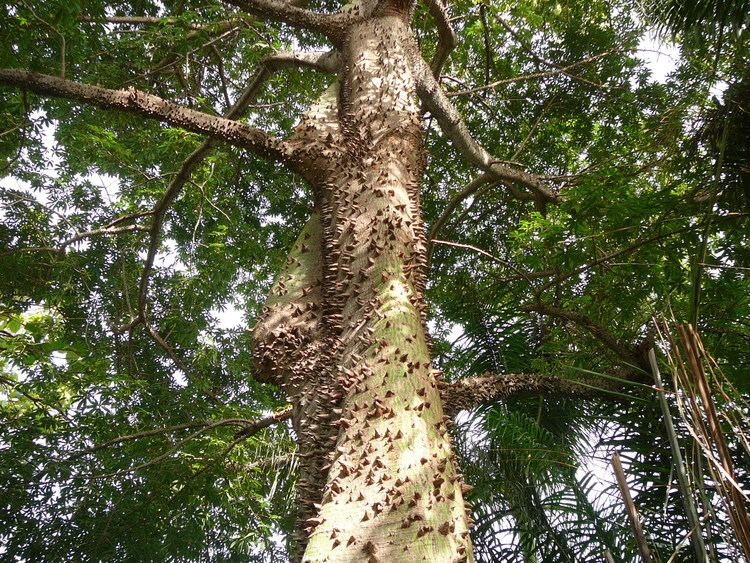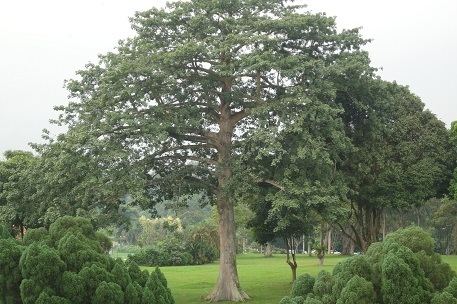Rank Species | Genus Ceiba Higher classification Ceiba | |
 | ||
Similar Ceiba, Bombax, Bombax ceiba, Bombacaceae, Mallows | ||
Ceiba pentandra silk cotton java kapok ceiba tree
Ceiba pentandra is a tropical tree of the order Malvales and the family Malvaceae (previously separated in the family Bombacaceae), native to Mexico, Central America and the Caribbean, northern South America, and (as the variety C. pentandra var. guineensis) to tropical west Africa. A somewhat smaller variety is found throughout southern Asia and the East Indies. Kapok is the most used common name for the tree and may also refer to the cotton-like fluff obtained from its seed pods. The tree is cultivated for the seed fibre, particularly in south-east Asia, and is also known as the Java cotton, Java kapok, silk-cotton, Samauma, or ceiba.
Contents
- Ceiba pentandra silk cotton java kapok ceiba tree
- Ceiba pentandra in full bloom
- Common Names
- Characteristics
- Uses
- Ethnomedical uses
- Kapok seed oil
- Religion and folklore
- Symbolism
- References

Ceiba pentandra in full bloom
Common Names

Characteristics

The tree grows to 70 m (230 ft), with reports of Kapoks up to 252 feet (77 meters) and a trunk often up to 3 m (9.8 ft) in diameter above the extensive buttresses. The very largest individuals however can be 19 feet (6 meters) thick or more above the buttresses. The trunk and many of the larger branches are often crowded with large simple thorns. These major branches, usually 4 to 6 in number and up to six feet (1.8 meters) thick form a crown of foliage as much as 201 feet (61 meters) in width. The palmate leaves are composed of 5 to 9 leaflets, each up to 20 cm (7.9 in) long. The trees produce several hundred 15 cm (5.9 in) pods containing seeds surrounded by a fluffy, yellowish fibre that is a mix of lignin and cellulose. The buttress roots can be clearly seen in photographs extending 40 to 50 feet (12 to 15 meters) up the trunk of some specimens and extending out from the trunk as much as 65 feet (20 meters) then continuing below ground for a total length of 165 feet (50 meters) The above reports make it clear that C. pentandra is among the largest trees in the world. One of the oldest known Kapok trees, at 200 years, lives in Miami, Florida.
Uses
Kapok fibre is light, very buoyant, resilient, resistant to water, but it is very flammable. The process of harvesting and separating the fibre is labour-intensive and manual. It is difficult to spin, but is used as an alternative to down as filling in mattresses, pillows, upholstery, zafus, and stuffed toys such as teddy bears, and for insulation. It was previously much used in life jackets and similar devices until synthetic materials largely replaced the fibre. The seeds produce an oil that is used locally in soap and can be used as fertilizer.

Native tribes along the Amazon River harvest kapok fibre to wrap around their blowgun darts. The fibres create a seal that allows the pressure to force the dart through the tube. When Pearl Harbor was bombed by the Japanese, a council was summoned that night in Washington, to consider what strategic commodities were threatened. According to John Kenneth Galbraith, the only reason the American war council could find to justify retaliation was that the 'kapok' supply was threatened; but although kapok was at the time listed among the strategic materials, no one present at the meeting was able to think what it was used for. The commercial tree is most heavily cultivated in the rainforests of Asia, notably in Java (hence its nicknames), Philippines, Malaysia, Hainan Island in China as well as in South America. The flowers are an important source of nectar and pollen for honey bees.
Ethnomedical uses

Ceiba pentandra bark decoction has been used as a diuretic, aphrodisiac, and to treat headache, as well as type II diabetes. It is used as an additive in some versions of the hallucinogenic drink Ayahuasca.
Kapok seed oil
A vegetable oil can be pressed from kapok seeds. The oil has a yellow colour and a pleasant, mild odour and taste, resembling cottonseed oil. It becomes rancid quickly when exposed to air. Kapok oil is produced in India, Indonesia and Malaysia. It has an iodine value of 85–100; this makes it a nondrying oil, which means that it does not dry out significantly when exposed to air. Kapok oil has some potential as a biofuel and in paint preparation.
Religion and folklore
The kapok is a sacred symbol in Maya mythology.
According to the folklore of Trinidad and Tobago, the Castle of the Devil is a huge kapok growing deep in the forest in which Bazil the demon of death was imprisoned by a carpenter. The carpenter tricked the devil into entering the tree in which he carved seven rooms, one above the other, into the trunk. Folklore claims that Bazil still resides in that tree.
Most masks coming from Burkina Faso, especially those of Bobo and Mossi people, are carved from the kapok timber.
Symbolism
C. pentandra is the national emblem of Guatemala, Puerto Rico, and Equatorial Guinea. It appears on the coat of arms and flag of Equatorial Guinea.
